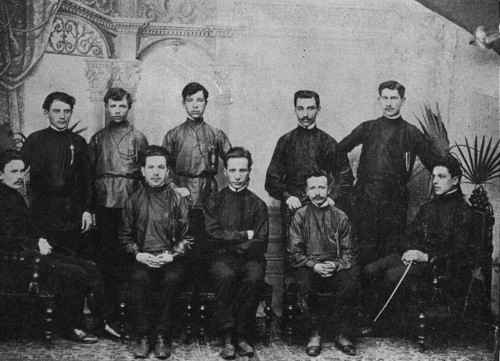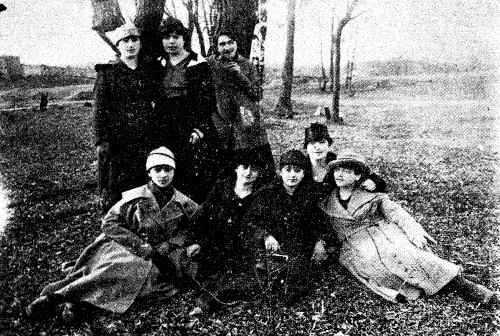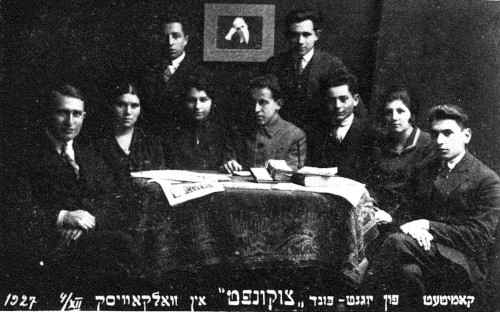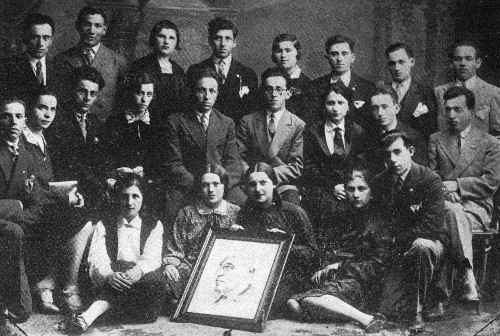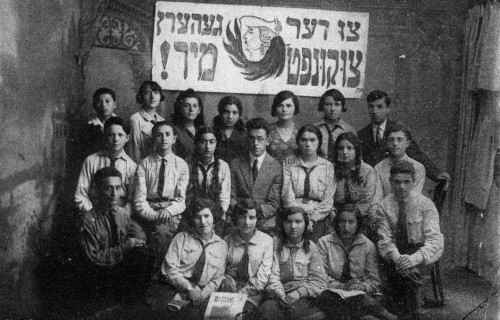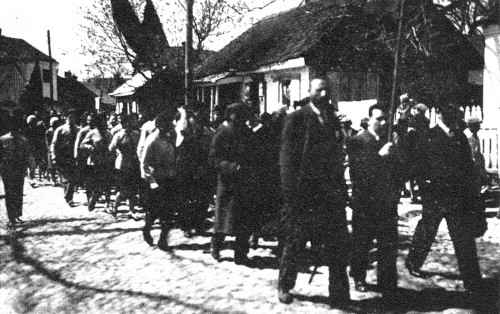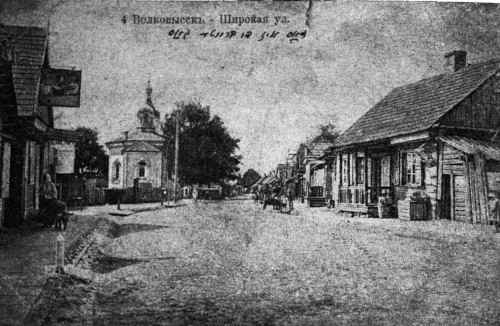[Page 69]
The Volkovysk Bund
Based on the information I received from Baylah Rivka Kushnir-Cahn (Berel Simcha's daughter) Hyman Shalkes (Cahn), Moshe'keh Katriel's (Zayak) and Shmuel Rothbart (Khudozhnik)
The Bund played a visible role in the Jewish community life of Volkovysk. In the year 1939, shortly before the last [sic: second] world war, the Bund attracted three thousand votes in the elections for the Volkovysk city government, and three Bund councilmen were elected at that time: Sh. Ravitzky, Yitzhak Merkin (the Teacher), and L. Schlossberg (from the brick factory). The leaders of the Bund in the community were: Sh. Lev, the butcher Shevakhovich, and Lifschitz. The Bund had its own local in Volkovysk and carried on a feverish level of community activity – organizing meetings, lectures, evenings, debates, tours, etc.
In the years immediately prior to the Second World War, the Volkovysk Bund also had [a chapter of] the Bundist youth organization called Zukunft, the Bundist children's organization, Skiff, and the Bundist sports organization Morgenstern. All these Bundist organizations were very active on the cultural and community fronts.
The History of the Volkovysk Bund
|
|
A Group of Bund Activists from the Year 1905
Right to Left, First Row, sitting:Herschel Zuckerman, Zaydl the Bookbinder, Joseph Captain (Likovsky), Moshe Yoss'l the Hatmaker, Michael Zohn-Mazya
Second Row, standing: Moshe Katriel's (Zayak), Berel Karpovich, Chaim Shalkeh (Cohen), Moshe'keh the Bone-Turner[1], Israel the Locksmith (from the Neuer Gasse) |
The history of the Bund in Volkovysk is analogous to the history of the Bund in hundreds of cities and towns throughout Poland and Lithuania. Starting at the beginning of the twentieth century as a small “circle,” it later grew into a powerful organization with a multi-branched party apparatus, which affixed its stamp on a significant portion of the Volkovysk Jewish population. Therefore, it is our assessment that it is proper here, to give a short overview of the founding and development of the Volkovysk Bund.
By the end of the nineteenth century, Volkovysk had a couple of hundred Jewish workers: part of them worked in Yanovsky's tobacco factory, in the beer breweries, in Bloch's tannery, and a portion were apprenticed by the community [as] – learning the trade of shoemakers, tailors and other workers. The condition of the workers and the apprentices was pathetic. True, the apprentices were at least certain of their meager next meal, which they obtained from their employer, but the trouble was that their employers thought of them, especially in the first years, as simple menials. They were compelled to clean house, help the woman of the house with her housework, run errands, and do all manner of heavy work before the worker would begin to instruct them in the skills of his trade. In addition to this, the apprentices were compelled to work on Saturday nights.
[Page 70]
Immediately following the Havdalah service, when the Maariv prayers were completed in the houses of worship, the apprentices would have to return, like the wicked condemned to Hell, to their darkened workplaces. The fate of the worker was not much better. He too, would have to slave away for long hours every single day for a mere pittance.
Translator's footnote:
- An artisan, who turned bone material on a lathe to create decorative objects. Return
The Struggle of the Apprentices with the Tradesmen
After the establishment of the Bund – In Vilna in 1897 – the Jewish worker in Volkovysk begins to awaken. He receives notices of worker strikes in the large cities. During the summer months, students from Vilna and other cities come to Volkovysk, teachers and plain intellectuals, who were mixed up in revolutionary activities, and they begin the work of clarification among the oppressed workers, and incite them to agitate for better working conditions and higher wages, and awaken in them their class identity.
The first strike in Volkovysk broke out under the slogan: “Abolish [work on] Saturday Night!” The tradesmen, however, did not want to give in and they attacked the perpetrators of the strike. Several of the “strong arm” types of young men aided the tradespeople, and beat up on the “Bundovchikehs.” An altercation of this type once broke out in front of the Synagogue at the time of the recitation of U'Nesaneh Tokef.[1] But the young workers had prepared themselves, and had recruited support from the surrounding towns, and prevailed against the tradespeople and their “shtarkers.[2]” Part of the young toughs regretted their position, and took sides with the Bundovchikehs. In the end, the apprentices won their battle, and Saturday night work was abandoned [as a routine practice.]
This victory energized the Jewish workers in Volkovysk, and they began to organize themselves for a mass demonstration. It happened, because of a student from Vilna by the name of Chaim Nemzer, who because of the Czarist decrees, lost his opportunity to continue with university studies there. He became a teacher of Russian in Volkovysk. He put his heart and soul into the organization of the Jewish workers, and he became the leader of the Volkovysk “Cell.”
Translator's footnotes:
- Obviously, the sanctity of the High Holy Days did not mitigate against this behavior. Return
- Yiddish for ‘a strong guy,’ implying a young ‘tough.’ Return
The Volkovysk Cell
|
|
A Group of Girl Friends from the Bundin the Year 1917
Right to Left, First Row, bottom: Myteh[1] Pikarsky, Ronya Fanar, Gittl Bayer, Kham'keh Lev, Leah'keh Ravitz
Standing: Pes'sha Kaplan (David Hirsch'l's), Itkeh from Porozovo, Rosa Levitt |
The “Cell” set itself the goal of organizing the workers – whether they worked for the various tradespeople, or whether they worked in the few factories which were in the city at that time – and to attract all sympathetic people to fight for decent working conditions for themselves and for a better lot for all of mankind.
[Page 71]
The founders of the Cell strived not only to improve the material well-being of the workers, but also to raise the workers to a higher spiritual plane and to spread education and reasoning among them. To this end, they founded a library, in which were found various forms of publication, and also popular science books and political books and brochures – legal and illegal. In that era, at the beginning of the twentieth century, the library served as a good means to attract candidates for the labor movement. The directors of the library would first give the new readers books of general interest – novels, and the stories of Jule Verne, Tannenbaum, and others – and later after they had gradually become acquainted with the character and emotional outlook of the reader, they would start giving them more serious books of a socialist and revolutionary character, and also illegal brochures that the Bundpublished. Later, when it was decided that the individual was a sympathetic and trustworthy person, he was brought into the Cell and invited him to secret evening [meetings], [regular] meetings, May First gatherings, which the Cell would organize – during the summer in the woods, and during the winter in designated houses. At these meetings, they would join hands and sing “Die Shvuah”[2] and various revolutionary and folk songs and the popular songs of that day: Doreen in Vinyl in Nasser Keller, and Der Gezaltzener Yam fun Menshlikhen Trerren.[3]
Translator's footnotes:
- Judeo-German diminutive from the common noun, meaning‘maiden.’ Return
- “The Oath” in Yiddish Return
- ’There in the Corner in the Damp Cellar’, and‘The Salty Sea of Human Tears’ Return
The Activists of the Cell
|
|
Committee of the Youth-Bund ‘Zukunft’l in the Year 1927
Right to Left, seated: The (I)zaveliner, Rosa Vlosky, Yud'l Stolovitsky, Yankel Rubinstein (the Locksmith's), Reizl, Chana Irmess, Shimon Lev (Son of Yehuda Hirsch the Butcher)
Standing: Hona Falkovich (the Tailor), Shmuel Pashinker |
|
|
The Mikhalevich Cell of the Youth Bund ‘Zukunft’
Left to Right, sitting: Yankel Lev, Yankel Pereminsky, Miss Pereminsky, Yankel Rubinstein (the Locksmith), Yankel Pashinker, Miss Rubinstein, Yud'l Zlotnitsky, Mrs. Pashinker, Bayer |
|
|
The Sakifist Youth Organization of the Bund
The picture shows Yankel Rubinstein, the Leader of the Bund |
The Steering Committee of the Volkovysk Cell consisted of from seven to eleven people, and each one had ten members of the Cell under his oversight whom he would have to indoctrinate and educate them politically and in a community sense.
The first founders of the Bund Cell were: Yud'l Likovsky and his brother Joseph (Captain), Moshe'keh Zakroy (Feivel the Shokhet's son), Baylah Rivka (daughter of Berel Simcha's), Berel Karpovich, Yankel Levin, (son of Tzipa the Sweet One[1]) and Rosa Einhorn.
[Page 72]
At the very beginning, the leadership consisted of eight people and the membership numbered thirty. Later, the Cell grew, numbering 70-80 people. Among its active adherents were: Chaim Nemzer, Moshe Katriel's (Zayak), Chaim Sholkess (Hyman Cohen), Moshe the [furniture] finisher, Yisroel'ikeh the Locksmith, Herschel Zuckerman, Zaydl the Bookbinder, Moshe Yoss'l the Hatmaker, Mikhl Zohn-Mazya, Mottel Chana Shosh'eh's, Yoss'l (Popiloy's son), Velvel the Baker, Jedediah the Baker, Yankel the Carpenter, Sima Chay'keleh's, Moshe Nakheh's (Son of Lapin the expediter), David Bogomilsky (Katriel the Baker's son), Shmuel Khudozhnik, Bodaneh[2] (The Tinsmith's daughter), Chay'keh the Grinder's daughter, Dvo'shkeh, Bobeh'leh Adef (Leizer Chaim's daughter), Pearl Lev (The Bialystoker Baker's[3] daughter), Avreml Adef (Leizer Chaim's son), Son of Sholom Barash, Hirscheleh (Bontsheh the Shoemaker's son), Litman (Mendel the Baker's son), Herschel Rokhkin, the younger L. Schlossberg (from the brick factory), Yankel the Dark One[4], Hona Gluck, Mendel Nissan (the Shokhet's son), David Einhorn, Zaydl Feinzilber, Golda Papess, Kayla (David Herschel's daughter), Chasia Salman, Bayl'keh the Hassid's, Jedediah Margolis, Moshe Tchopper, Berel Dzhik, Itcheh Niezhnik, Yankel Lifschitz, and others.
These very members would meet periodically in various houses in order to conduct their meetings. Among the gathering places, we must record here the houses of the following: the Likovskys (Chana Frieda's son, who lived on the Wide Boulevard), Baylah Rivka (Berel Simcha's daughter), the teacher, Berel Karpovich (who lived in the rented room, at Berel Kushnir's on Slutsky's street), and periodically in the Tiferet Bakhurim Synagogue. These secret meetings were known as “the meetings”.
During the summer, the secret meetings would be held in the Zamkover Forest, and once on the “Mayak.” These meetings were guarded by a special group of the members, who were thoroughly familiar with all the paths and byways of the vicinity, in order to interdict the intrusion of unfamiliar people, and one was always ready in case of a betrayal, to elude the grasp of the police. These meetings were mostly held in the afternoons of the Sabbath or on Holidays. In the forest on the grass, one could often listen to fiery oratory, which had the character of indoctrination, and informed the members about strikes, self-defense, and in general about the activities of the Bund.
At these secret meetings, plans were worked out for attacking government convoys and whiskey monopolies, and expropriating money in order to have resources to carry out revolutionary work. An attack of this sort was once carried out in Izavelin. The telephone wires were cut, and the expropriation was carried out.
Berel Dzhik was once arrested for political activity. So, on a dark night, the members of the Cell sawed through the iron bars of the jail, took Berel out, and hid him in Baylah Rivka's house. The authorities conducted searches in many of the local houses, Kareyev, the well-known police officer, accompanied by gendarmes, made a “sortie” against Baylah Rivka's house to look for the prisoner. But Berel, disguised as an elderly Jewish woman, managed to sneak out of another door and vanished.
It would happen that the group would attack convoys that were taking in revolutionary prisoners, throw tobacco into their faces, and in the ensuing confusion, free the prisoners.
[Page 73]
In October 1905 – when all of Russia seethed with revolutionary activity, on October 18, the Volkovysk Bundists prepared themselves on that day to mount a big demonstration. It so happens, that Yoss'l Kishke, a member of the Cell, died that day. The Cell decided to transform the funeral procession for their comrade into a grandiose demonstration. Baylah Rivka (Berel Kushnir's daughter) specially sewed up two flags – a black one and a red one. Yud'l Likovsky gave the eulogy and held forth with a fiery, flaming speech. The stores were all closed, and masses of people participated in the big funeral procession – which lingered in the memory of the Volkovysk residents for a long time.
A strong push to the development of the Volkovysk Bund was provided by the visit of the leader of the central committee of the Bund – Wladek – “The Young LaSalle,” whose presentation in Poliakov-Lev's Bet HaMedrash made a strong impression.
Translator's footnotes:
- More likely to be a sobriquet connected with a trade, such as selling sweets, rather than a personality trait. Return
- From a Slavic composite, meaning ‘given by God.’ Return
- It is not possible to easily tell whether the baker was from Bialystok, or if he was from Volkovysk, and specialized in baking the famous Bialystoker kuchen. Return
- Difficult to know if this was because of a swarthy complexion or because of dark hair. Return
The Bund Prior to the Second World War
|
|
A May 1st Demonstration with Bund Participation |
|
|
The Wide Boulevard (Near the Church)
|
Years went by. A slaughterhouse and meat-processing factory were built in Volkovysk. Then came houses, buildings, mills, brick factories, businesses, sawmills, and the number of Jewish workers and laborers grew, and the Bund grew with them.
Among the leaders and activists of the Bund, prior to the Second World War, were: Yankel Rubinstein (Son of Yud'l the Locksmith), Shmuel Pashinker, Abraham Markus, M. Zeleviansky, Berel Falkovich, Shimshon Lev (Son of Yehuda the Butcher), Yankel Lev, Yitzhak Merkin, L. Schlossberg, Sh. Ravitzky, Hona Falkovich, The man from (I)zavelin, Rosa Vlosky, Yud'l Stolovitsky, Chana Irmess, Abba Shtumer, and Yankel Pereminsky.
* * *
As previously stated, the Volkovysk Bund was very active in the years between the two World Wars, and often brought in speakers from Vilna and Warsaw, celebrated worker holidays in a nice manner, as well as the Bund “Jubilees.” From time to time, regional conferences of the Bund were held in Volkovysk. The Volkovysk Bund bubbled with life and activity, and would often arrange concerts, presentations, evenings and undertakings – until it went under, along with the entire Jewish population of Volkovysk.
This material is made available by JewishGen, Inc.
and the Yizkor Book Project for the purpose of
fulfilling our
mission of disseminating information about the Holocaust and
destroyed Jewish communities.
This material may not be copied,
sold or bartered without JewishGen, Inc.'s permission. Rights may be
reserved by the copyright holder.
JewishGen, Inc. makes no representations regarding the accuracy of
the translation. The reader may wish to refer to the original material
for verification.
JewishGen is not responsible for inaccuracies or omissions in the original work and cannot rewrite or edit the text to correct inaccuracies and/or omissions.
Our mission is to produce a translation of the original work and we cannot verify the accuracy of statements or alter facts cited.
 Vawkavysk, Belarus
Vawkavysk, Belarus
 Yizkor Book Project
Yizkor Book Project
 JewishGen Home Page
JewishGen Home Page
Yizkor Book Director, Lance Ackerfeld
This web page created by Jason Hallgarten
Copyright © 1999-2026 by JewishGen, Inc.
Updated 25 Sep 2022 by LA
